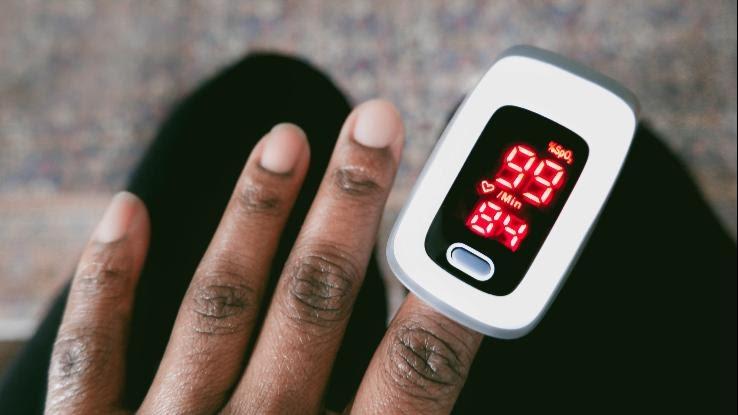When Reading, What Should You Look for First?

Pulse oximetry measures how much oxygen is being carried by one's claret throughout their body while their heart is pumping. So, how is this measured? Namely through pulse oximeters, small-scale devices that are used in hospitals, clinics and homes to measure out heart rate and claret oxygen saturation.
Unlike a clinical blood test, pulse oximeters allow for virtually-instant results — and they're completely non-invasive. Simply sideslip the device on the end of your finger or toe and yous'll have results in seconds. First developed back in 1974 past Japanese bioengineer Dr. Takuo Aoyagi, pulse oximeters were fabricated commercially bachelor for at-home monitoring in 1995. Since then, personal pulse oximeters have immune folks with lung, animate and middle conditions to runway their own readings and monitor their daily levels. So, how practice these wondrous devices work?
Pulse oximeters are made upward of ii components: a sensor unit and a display. The sensor unit measures 1's pulse (or center charge per unit) as well as the oxygen saturation of 1's blood.

Pulse (or Heart Rate): Your pulse is the rate at which your heart beats. It is usually listed every bit beats per minute (bpm). The oximeter'due south probe detects the menses of blood through whatsoever part of the body it is clipped to — usually the end of a finger or toe (and, in some cases, an earlobe). The brandish on the oximeter will nowadays the pulse information in two ways: a pulse wave signal that will bear witness how regular, erratic, weak said pulse is, and every bit a number, which specifies the wearer's bpm.
Blood Oxygenation: Pulse oximeters use light-emitting diodes (LEDs) that project two types of carmine low-cal into the tissue of the wearer's finger, toe or ear. One side of the oximeter will concord the LED that projects that light; the other side of the oximeter volition include a sensor that detects the light that has travelled through the wearer'southward flesh. The oximeter then calculates what percentage of your claret is carrying oxygen by measuring the change in the absorption of light past oxygenated blood (that is, the blood that's carrying oxygen) and deoxygenated blood (blood that does not contain oxygen). The result volition be displayed as a measure of Blood Oxygen Saturation (referred to equally SpO2), which is given as a pct.
In improver to being used to mensurate ane's operation nether stress or track their daily health, pulse oximeters are used to monitor vital signs during surgery, especially while you lot're under anesthesia. Apart from personal devices, blood oxygenation measurements tin can be calculated in clinical settings through an arterial blood gas (ABG) exam. Although this ABG test is extremely precise, it's much more invasive than a personal pulse oximeter. In short, at-abode pulse oximeters empower you lot to manage your ain wellness and, while they shouldn't be used for diagnostic purposes, their immediacy can certainly aid you stay informed and aware.
Interpreting Pulse Oximeter Readings
And then, how do you know what your readings mean? The Mayo Clinic suggests that the normal resting pulse rate for adults should autumn between threescore and 100bpm. That'due south a pretty wide range — and one that accommodates for variation in gender, age, weight, level of concrete action and more. Generally speaking, a pulse charge per unit at the lower stop of that range means that your centre is functioning more than efficiently than a heart that is required to beat out more frequently each minute while at rest.

At a certain indicate, though, lower is not meliorate. The medical status bradycardia is when one's resting eye charge per unit is unusually low — that is, at or below 60bpm. Bradycardia'southward symptoms include memory challenges, fainting, tiredness and chest pain.
So, what well-nigh blood oxygenation? Every bit y'all may know, your blood carries oxygen from your lungs to cells throughout your body. The commitment of oxygen at the right levels is essential to life and health. The air that we typically breathe contains approximately 21% oxygen. Standard blood oxygen saturation — in someone without lung affliction — is typically between 95% and 100% when measured with an oximeter and expressed as SpO2. When measured via an ABG, which expresses results in mmHg, standard blood oxygen saturation is between lxxx and 100 mm Hg. Typically, a SpO2 reading of below 95% is considered low.
Breathing oxygen at also high a concentration causes hyperoxia, a potentially dangerous condition that tin can crusade impairment to your lung tissue. On the other hand, not getting enough oxygen tin can cause hypoxemia. Symptoms of hypoxemia include headaches; shortness of breath; rapid heart rate; coughing and wheezing; mental confusion; and a blueish tinge to your peel and lips. The consequences of hypoxemia range from relatively minor — frequent headaches and shortness of jiff — to extremely severe in farthermost cases, such every bit an interference with centre function. Hypoxemia can stalk from many factors, including heart and lung atmospheric condition; asthma and emphysema; high altitudes; certain pain medications; and sleep apnea. According to the Us Nutrient & Drug Administration (FDA), severe cases of the flu and COVID-19 may likewise crusade oxygen levels to drop to the point where supplemental oxygen is required.
Of form, these figures are generalizations and don't accept into account 1's specific wellness conditions, similar chronic obstructive pulmonary disease (COPD) or other lung disorders, which might impact blood saturation. For that reason, oximeter readings taken at dwelling should never be relied on for diagnostic purposes or to decide handling. If you lot are concerned by your at-abode readings, seek medical advice to understand what those readings bespeak in the larger context of your health.
Resources Links:
- "Pulse Oximetry" via the Mayo Clinic
- "Pulse Oximeters and Oxygen Concentrators: What to Know Nearly At-home Oxygen Therapy" via United States Nutrient & Drug Assistants (FDA)
Source: https://www.symptomfind.com/health/interpret-pulse-oximeter-readings?utm_content=params%3Ao%3D740013%26ad%3DdirN%26qo%3DserpIndex
0 Response to "When Reading, What Should You Look for First?"
Post a Comment